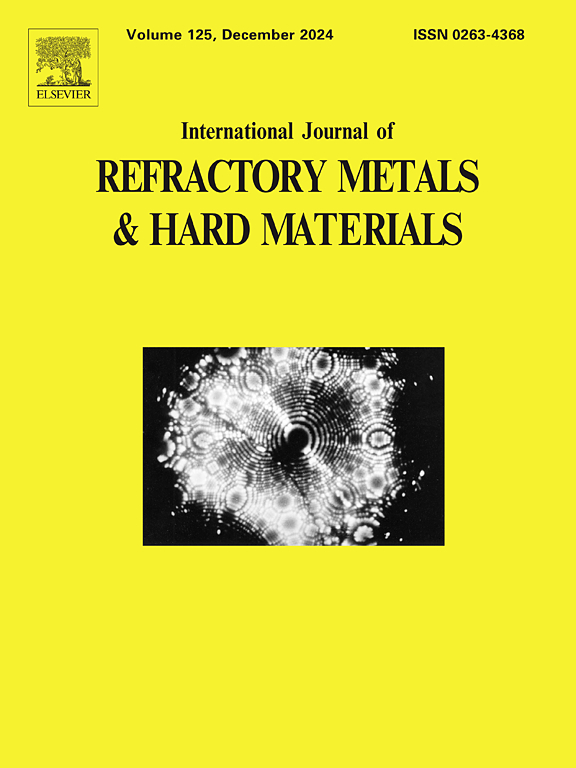Effect of metal combined with non-metallic additives on the microstructure and properties of B4C ceramics via pressureless sintering
IF 4.2
2区 材料科学
Q2 MATERIALS SCIENCE, MULTIDISCIPLINARY
International Journal of Refractory Metals & Hard Materials
Pub Date : 2025-04-23
DOI:10.1016/j.ijrmhm.2025.107205
引用次数: 0
Abstract
This paper studies the effect of Ti combined with different non-metallic sintering additives (Y2O3, ZrO2, TiO2, SiC) on the microstructure and mechanical properties of pressureless sintered B4C. B4C ceramics were successfully prepared by pressureless sintering at 2000 °C. The phase composition, microstructure and mechanical properties of the samples were analyzed. The results indicate that different non-metallic sintering additives exert distinct influences on the mechanical properties of B4C ceramics, and their toughening mechanisms are also different. Additionally, TiB2 and ZrB2 formed in situ during the sintering process form the (Zr, Ti)B2 solid solution, which significantly enhancing the fracture toughness and hardness of B4C ceramics. In this study, the sample with 2.5 wt% Ti, 3 wt% carbon black and 10 wt% SiC showed the best properties. The relative density, Vickers hardness, fracture toughness and flexural strength were 94.4 %, 28.9 GPa, 3.58 MPa·m1/2 and 221 MPa, respectively.
金属与非金属添加剂复合对无压烧结B4C陶瓷显微组织和性能的影响
本文研究了Ti与不同非金属烧结助剂(Y2O3、ZrO2、TiO2、SiC)复合对无压烧结B4C显微组织和力学性能的影响。采用2000℃无压烧结法制备了B4C陶瓷。分析了试样的相组成、显微组织和力学性能。结果表明,不同的非金属烧结添加剂对B4C陶瓷的力学性能有不同的影响,其增韧机理也不同。烧结过程中原位生成的TiB2和ZrB2形成(Zr, Ti)B2固溶体,显著提高了B4C陶瓷的断裂韧性和硬度。在本研究中,Ti含量为2.5 wt%,炭黑含量为3 wt%, SiC含量为10 wt%的样品表现出最好的性能。相对密度为94.4%,维氏硬度为28.9 GPa,断裂韧性为3.58 MPa·m1/2,抗弯强度为221 MPa。
本文章由计算机程序翻译,如有差异,请以英文原文为准。
求助全文
约1分钟内获得全文
求助全文
来源期刊
CiteScore
7.00
自引率
13.90%
发文量
236
审稿时长
35 days
期刊介绍:
The International Journal of Refractory Metals and Hard Materials (IJRMHM) publishes original research articles concerned with all aspects of refractory metals and hard materials. Refractory metals are defined as metals with melting points higher than 1800 °C. These are tungsten, molybdenum, chromium, tantalum, niobium, hafnium, and rhenium, as well as many compounds and alloys based thereupon. Hard materials that are included in the scope of this journal are defined as materials with hardness values higher than 1000 kg/mm2, primarily intended for applications as manufacturing tools or wear resistant components in mechanical systems. Thus they encompass carbides, nitrides and borides of metals, and related compounds. A special focus of this journal is put on the family of hardmetals, which is also known as cemented tungsten carbide, and cermets which are based on titanium carbide and carbonitrides with or without a metal binder. Ceramics and superhard materials including diamond and cubic boron nitride may also be accepted provided the subject material is presented as hard materials as defined above.

 求助内容:
求助内容: 应助结果提醒方式:
应助结果提醒方式:


